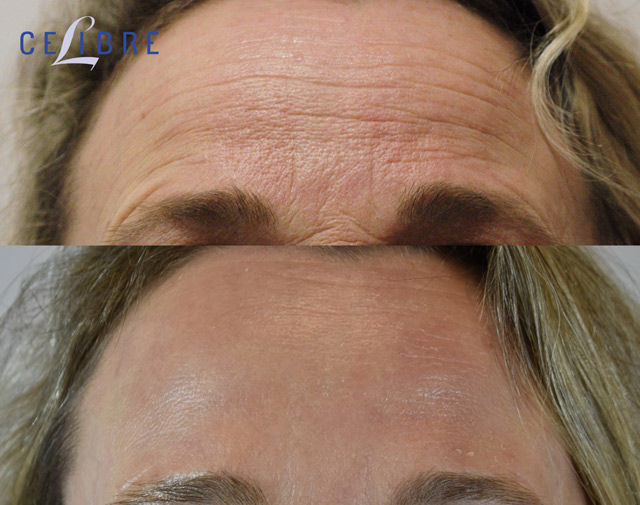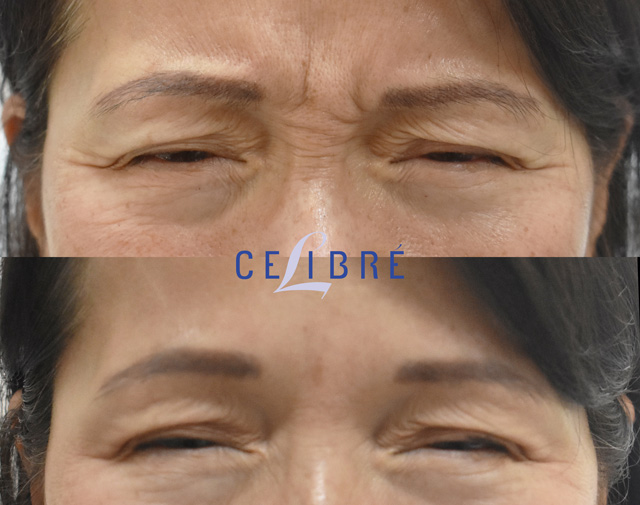Frown lines, also called furrow lines or glabellar lines, are vertical creases that form between the eyebrows and extend upward toward the forehead. These lines are a natural part of aging and expression, but many of our patients find them frustrating. Some tell us that their co-workers, friends, or family members believe they are angry because of their often-present frown.
In over 20 years of treating frown lines, we have found some excellent options to help maintain a youthful, smooth complexion and some not-so-great options as well.
What Causes Frown Lines?
Frown lines form due to several factors, some of which are beyond our control, while others can be managed with lifestyle changes. The main contributors include:
- Aging: As we age, our skin loses elasticity and collagen, causing it to sag and become less resilient to repetitive muscle movements. The dermis (collagen layer) thins, and the fat that keeps skin plump decreases, making lines and creases more noticeable.
- Facial Expressions: Constant frowning, squinting, or furrowing of the brows causes muscles to contract repeatedly, which eventually creates creases in the skin. Over time, these temporary lines become etched in permanently.
- Sun Damage: UV radiation from the sun breaks down collagen and elastin fibers in the skin, accelerating the aging process. Sun exposure can also lead to dehydration, making skin less supple and more prone to wrinkling.
- Lifestyle Factors: Smoking, poor diet, lack of sleep, dehydration, and stress can further contribute to the formation of frown lines. Smoking, for example, constricts blood vessels and impairs the skin’s ability to repair itself.
- Genetics: Some people are genetically predisposed to developing deeper or earlier frown lines. If your parents had prominent frown lines, you might develop them as well.
Preventing Frown Lines
Preventing frown lines can be challenging, especially since facial expressions are an integral part of communication and emotion. However, a few preventive measures can delay their onset or reduce their severity:
- Use Sunscreen: Sunscreen is the most crucial defense against sun damage, which contributes significantly to the development of wrinkles. A broad-spectrum sunscreen with SPF 50 or higher should be applied daily, even on cloudy days, to protect your skin from harmful UV rays.
- Moisturize and Exfoliate Regularly: Exfoliation with products such Retin A, retinol and glycolic acid help renew the skin, diminishing the appearance of fine lines and stimulating the production of collagen. Keeping your skin hydrated with a good moisturizer can help maintain its elasticity and plumpness, further reducing the appearance of fine lines.
- Adopt a Healthy Diet: Eating foods rich in antioxidants, such as fruits, vegetables, and nuts, can help neutralize free radicals that cause skin damage. Omega-3 fatty acids, found in fish and flaxseeds, are also beneficial for maintaining skin’s elasticity.
- Avoid Smoking and Limit Alcohol: Smoking accelerates skin aging by reducing blood flow and depleting collagen, while excessive alcohol can dehydrate the skin, making wrinkles more pronounced.
- Manage Stress: Chronic stress can lead to repetitive frowning, which over time, can cause deeper lines to form.
- Proper Sleep Habits: Sleeping on your back can prevent pressure on the face, which can deepen wrinkles. Make sure you are getting enough sleep to allow your skin to repair and regenerate.
Non-Invasive Treatments for Frown Lines
If preventive measures are not enough, there are a variety of non-invasive treatments available that can help smooth out frown lines without the need for surgery.
- Topical Retinoids: Retinoids, derived from vitamin A, are well-known for their anti-aging properties. Retinoids stimulate collagen production and speed up cell turnover, reducing the appearance of fine lines and wrinkles. Prescription-strength retinoids like tretinoin (Retin A) are highly effective, but over-the-counter options with retinol can also provide benefits.
- Chemical Exfoliants: Chemical exfoliants such as glycolic, salicylic and kojic acid increase the cell turnover rate, helping to preserve collagen while making the skin appear youthful and fresh.
- Microdermabrasion: This procedure uses tiny crystals or a diamond-tipped wand to remove the outer layer of dead skin cells, stimulating collagen production and reducing the appearance of frown lines. It is a minimally invasive treatment that provides a smoother skin texture with minimal downtime. It accomplishes the same goal of exfoliation that topical retinoids and chemical exfoliants do but usually at a higher price.
- Laser Therapy: Laser treatments, such as full field or fractional laser resurfacing, work by creating micro-injuries in the skin, which stimulate collagen production and help smooth out wrinkles. This treatment is more intense than other non-invasive options but can provide long-lasting results. A recovery period of several days to several weeks is required for laser resurfacing.
- Dysport, Botox & Other Neurotoxins: Dysport and Botox (both botulinum toxin type A) are two of the most popular non-surgical treatments for frown lines. They work by temporarily relaxing the muscles responsible for creating the frown lines, resulting in smoother skin. These injections are quick and minimally invasive, with results lasting 3-6 months. They are a great option for those who want immediate results without downtime.
Other Treatments for Frown Lines
For those seeking more significant or longer-lasting results, medical treatments may be a viable option. These treatments are more invasive but can offer dramatic improvements in the appearance of frown lines.
- Dermal Fillers: Hyaluronic acid fillers like Restylane can be injected into frown lines to plump the skin and smooth out indentations. Unlike Botox, which relaxes muscles, fillers add volume to the skin, making them a good option for deeper creases. At our practice, dermal fillers such as Restylane are typically used after we relax frown lines with Dysport (Botox). If ridges or indentations persist after Dysport injections, we then use dermal fillers.
- Microneedling with PRP: Microneedling involves creating tiny punctures in the skin to stimulate collagen production. The treatment is often combined with platelet-rich plasma (PRP), derived from the patient’s blood. We have found Microneedling and PRP to be poor alternatives for long term improvement of the frown lines.
- Radiofrequency Therapy: Radiofrequency (RF) treatments use heat energy to stimulate collagen production deep within the skin. We have found treatments like Thermage and Morpheus8 to be poor alternatives in the treatment of frown lines.
- Surgery: For those with deep, permanent frown lines, surgical techniques can be used to limit the strength of the muscles in the area, causing an improvement of the appearance of the frown lines.
Summary
Frown lines are a natural part of aging, but they do not have to be permanent. From preventive care to advanced medical treatments, there are numerous ways to reduce or eliminate these lines. The best approach will depend on your skin type, the severity of your frown lines, and your personal preferences regarding invasiveness and cost.
By taking care of your skin through proper sun protection, hydration, and a healthy lifestyle, combined with non-invasive or medical treatments, you can maintain a youthful, smooth appearance and reduce the impact of frown lines over time.














































